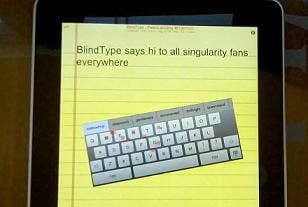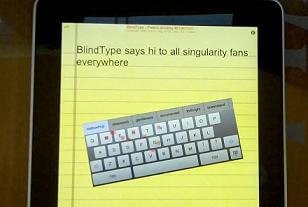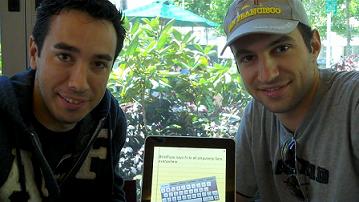Exclusive: I Used BlindType, Virtual Keyboard of the Future

Share
Typing on the iPhone is like squeezing sausages into a soda can - you can get it to work, but it's not pretty. BlindType is changing that. The startup has created a new touchscreen keyboard program of the same name that changes size, orientation, and position to match your wandering fingers as they type. BlindType also features some of the most impressive typing correction software I've ever seen. The result is a practical touchscreen interface that knows what you meant to type, even if you make mistakes. Lots of them. In fact, you can type without looking at the screen at all! It's amazing, and I got to see it in person when I visited with BlindType creators Kostas Eleftheriou and Panos Petropoulos in San Francisco. Check out their demonstration video below. It's hard to believe that they developed this software in less than one year.
Because BlindType is still under development Kostas and Panos would only let me take still shots of the program. Yet as you can see in their public demo video, BlindType lets the user be sloppy. When I tried the program on an iPad I could relax about mistakes. Not in spelling, but in the actual way I actually tried to hit keys on the touchscreen keyboard. Do you have fat fingers like me? Not a problem. Do your hands migrate slowly as you type? It can handle that too. Hold your iPad to one side, type in progressively larger or smaller movements, even ditch the keyboard altogether. BlindType can deal with it all. Just watch and learn:
If you found the above demonstration for BlindType impressive, you're not alone. The video received more than 300,000 hits in its first week. Those are great numbers for a tech demo from a startup on YouTube. Kostas and Panos were so impressed with the positive response they even created a follow up thank you video:
Why all the hullabaloo? BlindType is easing one of the biggest fears people have about touchscreen interfaces: they don't trust a keyboard without feedback. BlindType doesn't let you feel the letters but it does give you a lot of confidence in your typing. Kostas and Panos wanted a system that assumed the typist knew what they were doing. If you type one letter on the right, another on the left, and you don't directly hit the keys, BlindType tries to figure out what you meant to hit. Sometimes it can surprise you. Kostas and Panos dared me to see how poorly I could type and still have the right word appear. I typed without really looking at the keyboard and entered something like "ubvunvryjankt". BlindType knew I meant "inconceivable". I was amazed. Kostas and Panos laughed, they get that all the time.
That's when I really felt challenged and I tried my absolute damnedest to defeat BlindType. I'm glad I did. I learned how robust the system is. We turned off the keyboard. It didn't appear on the iPad screen at all. I typed in different directions, different speeds, and randomly changed the space I put between the letters I was trying to type. BlindType handled it all with relative ease. When I entered in new words the program didn't know (like my last name), a little menu popped up letting me store them in a custom dictionary with just one touch. Easy.
Of course it's not perfect. As Kostas and Panos helped me see, the program has limitations. BlindType is a typing correcter, not a spelling correcter. If you mistype a word by adding or subtracting a lot of letters, it doesn't work well. It comes with a spell-checker/auto-correction feature (or it will) but don't expect it to perform wonders on both typing and spelling simultaneously. It's good, but there's only so much decoding that's mathematically possible.
There's also limitations on the physical side of things. You have the choice of leaving the spacebar enabled or disabled. If you enable it, then there's a fixed point on an otherwise unfixed keyboard. That means you have to actually hit the spacebar button where it's supposed to be - that's not always easy if you're typing sloppily. If you disable the spacebar then spaces are inputed by swiping left to right. That's a reasonable adaptation to ask of a user, but it takes a little getting used to.
And Kostas and Panos are still working out how to get the program to differentiate between very fast typing and swiping. So if you type as fast as you possibly can sometimes the program thinks that two letters next to each other was actually you trying to make a swiping motion. Same with resting your fingers on the touchscreen - right now the program thinks you are trying to make a long swipe. Panos said they could solve that pretty easily in the future.
More limitations? Sure: if you have to swipe left to right, then as you rotate the phone (or iPad) you have to be careful about what direction it considers left to right. There's a little arrow to help you keep track of this, and the program reorientates itself after every new word, but you can, if you're nasty, confuse BlindType by typing things upside down or backwards (I told you I felt challenged). Most users aren't going to intentionally try to cause a failure though, so this is a very minor limitation.
Be Part of the Future
Sign up to receive top stories about groundbreaking technologies and visionary thinkers from SingularityHub.


All in all, I was simply blown away by how BlindType transformed me from a timid typist into a bold keyboard-challenging beast. I was so confident in the program's skills (in just a few minutes of using it!) that I was typing super sloppy and expecting the best. And I got it the vast majority of the time.
With the product being so sound, I was naturally interested in how it worked, and how they developed it. That's when Kostas and Panos got very tight-lipped. They've received so much attention, from apparently some big name people, that they can't discuss anything. They won't even generally describe how BlindType approaches the problem. I guessed it was analyzing the relative position between finger taps and they just gave me their best poker faces. No revelations at all. Kostas did allude to the fact that this is an AI project...but not much was said beyond that.
And BlindType is a small company, so there's little chance that the secrets will leak out. In fact, BlindType really just has two employees: Kostas and Panos - cousins from Greece. Though they've had help with testing and such, the two of them essentially developed this program on their own. That floored me. How long did it take them to create it? A few months! Though Panos admitted they have been thinking about it "for about a year."
Just as they are reluctant to discuss the specifics of BlindType's inner workings, Kostas and Panos are not giving details about their funding or ongoing agreements with manufacturers. Will it be installed on the manufacturing side or the consumer side (like an App)? No comment. If it is consumer-side, will it be free, $1, or $25? No comment. The only real answer I got from them is when I asked them if they had enough money to fund the rest of the program's development. They gave me enigmatic smiles and said, "oh, we've got no worries."
Clearly they think BlindType is going to be big. Will it succeed? Well, users are attracted to the promise of a better system, that much is clear. Touchscreen keyboards and predictive text algorithms are also a big business. Currently there are hundreds of millions of touchscreen devices sold each year and those numbers only look to rise as slate computers like the iPad gain ground. Nearly every single one of these machines needs a virtual keyboard and associated auto-correction software. When I asked Kostas and Panos which devices they were looking to port BlindType to, they simply said "all of them." Or at least as many as they could. Their goal, which is also stated on their website, "is to become the largest player in the industry." The potential rewards of that industry are large. Back in 1999, the T9 predictive type software sold for $350 million in stock to AOL, though it was sold again in 2007 for just $269 M.
In the short term, BlindType is going to focus on mobile touchscreens. The program runs on iPad and iPhone and will be running on Android phones soon. That's millions of units right there. But Kostas and Panos talked about it eventually being used on all kinds of touchscreens, from new PC desktops to street kiosks. And what about phones with little plastic keyboards like the Blackberry? BlindType could easily be adapted to improve accuracy there too. In fact, chances are that BlindType could be used in just about every keyboard (virtual or physical) there is. Think about that. This is a huge product.
It's probably coming to you soon. While they won't reveal specifics about product launch, Kostas and Panos said that beta testing will happen soon. Working with the product as I did, it seemed really close to ready. Kostas said that it takes about 150 milliseconds for BlindType to process each word, and the industry standard is 200 ms, so that's a good sign this product is good to go. As BlindType makes more announcements about it's progress, we'll keep you up to date.
And what does all of this have to do with the Singularity and accelerating technology? Artificial intelligence is analyzing flawed human output and predicting what the person 'really meant'. There's a lot of potential there. BlindType is a narrow application, but as AI gets better at interpreting human input, it will let us use machines more naturally. Right now we're worried about virtual keyboards, but think about brain computer interfaces. Computers won't just have to decode sloppy typing, they'll have to decode sloppy thoughts. Programs like BlindType are only the beginning. As machines and humans become more interconnected, we'll need more ingenious ways of building confidence in those connections. Kostas and Panos may have solved virtual keyboard problems in a few months. Let's hope our future user interfaces will be able to be improved as quickly.
[image credits: Aaron Saenz/Singularity Hub]
[video credit: BlindType]
[source: BlindType]
Related Articles

This Light-Powered AI Chip Is 100x Faster Than a Top Nvidia GPU

How Scientists Are Growing Computers From Human Brain Cells—and Why They Want to Keep Doing It

These Brain Implants Are Smaller Than Cells and Can Be Injected Into Veins
What we’re reading

